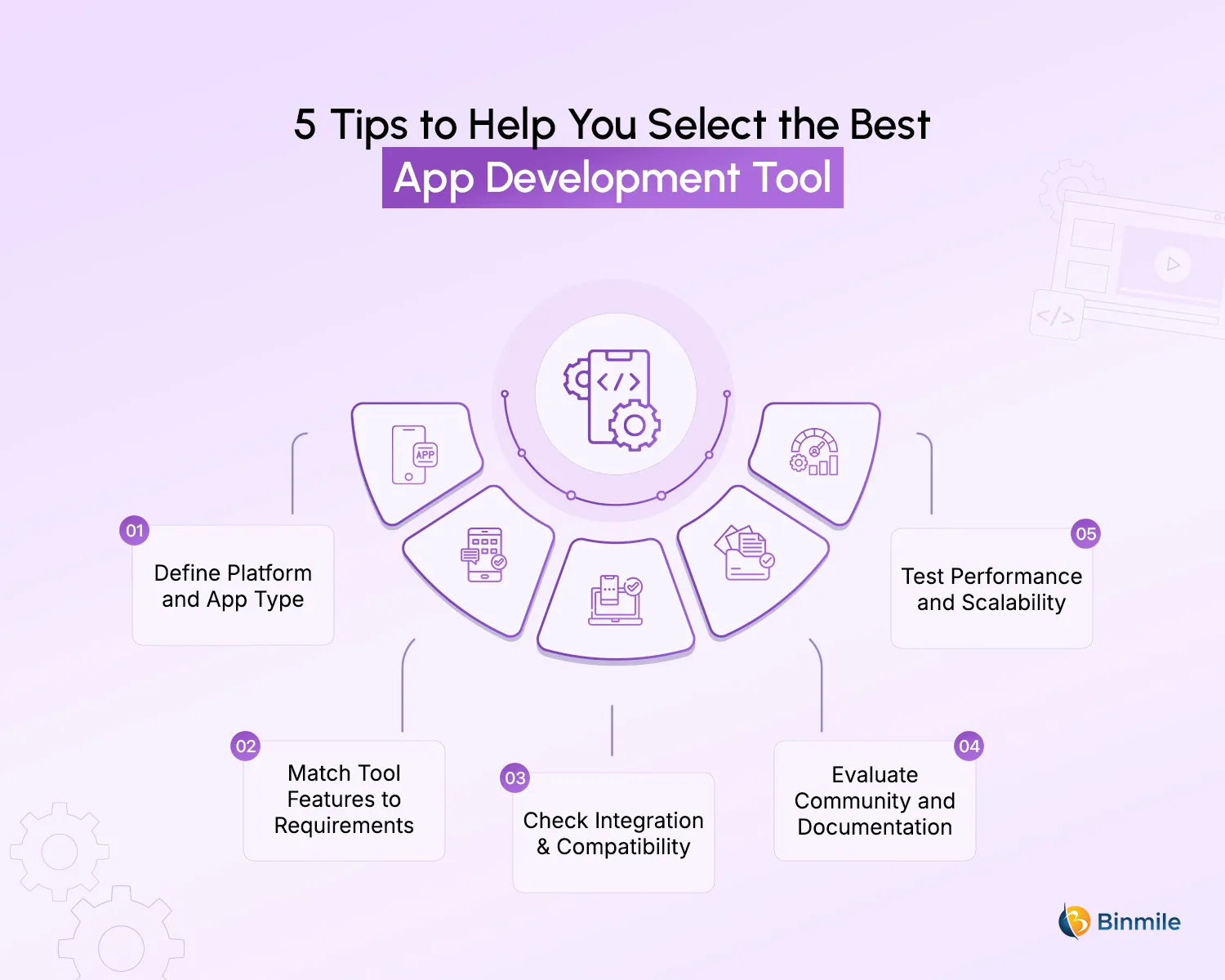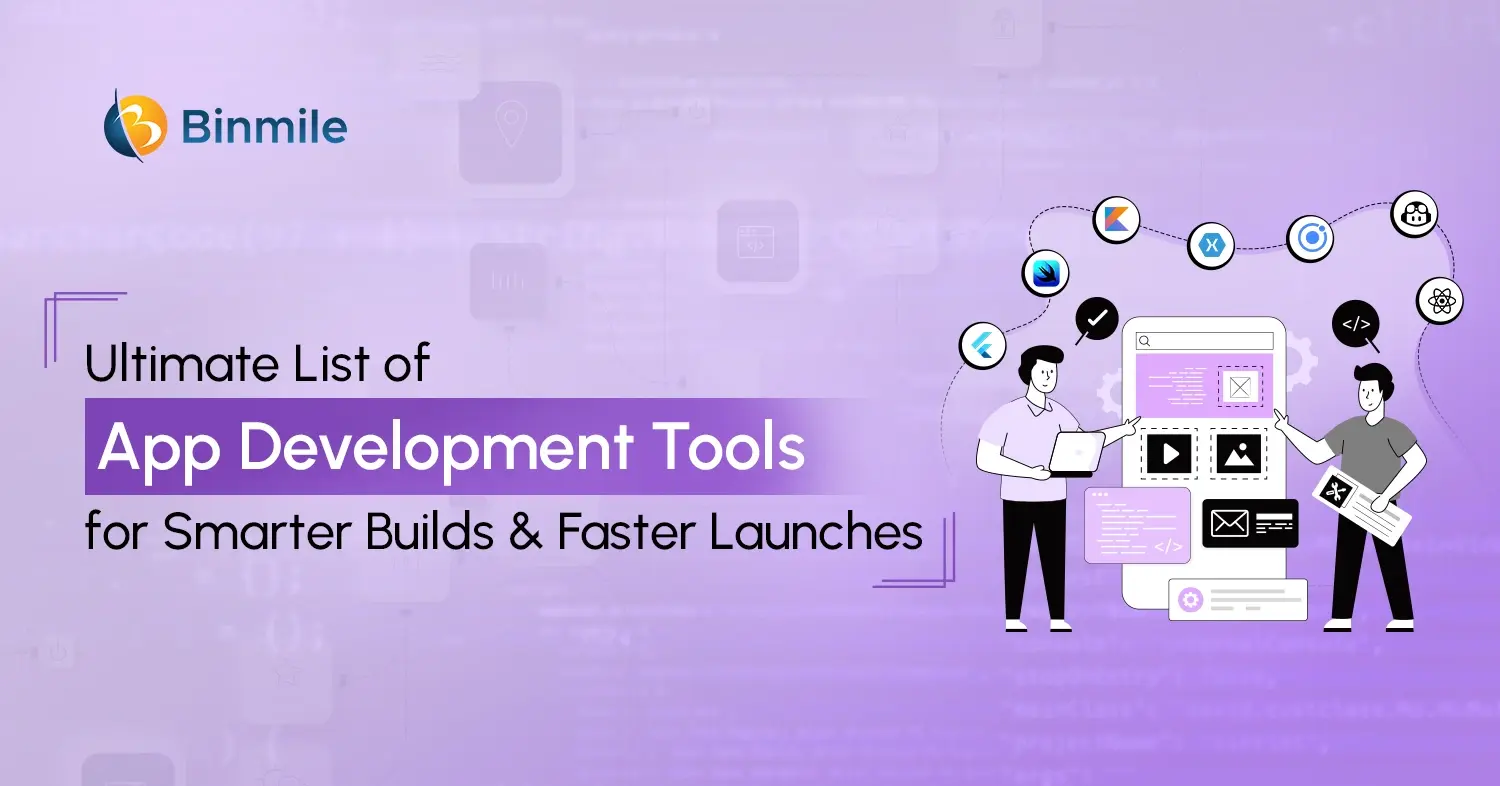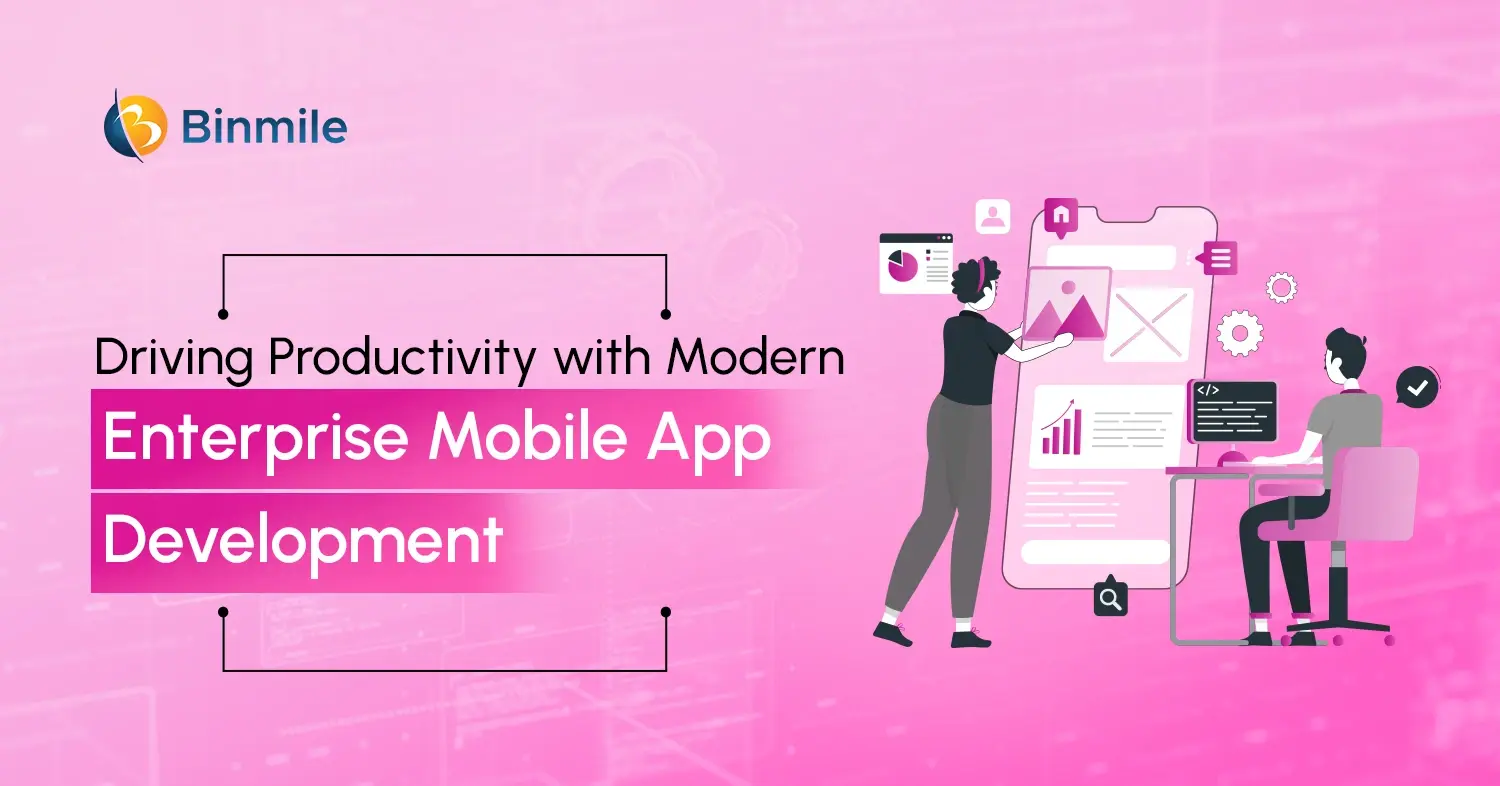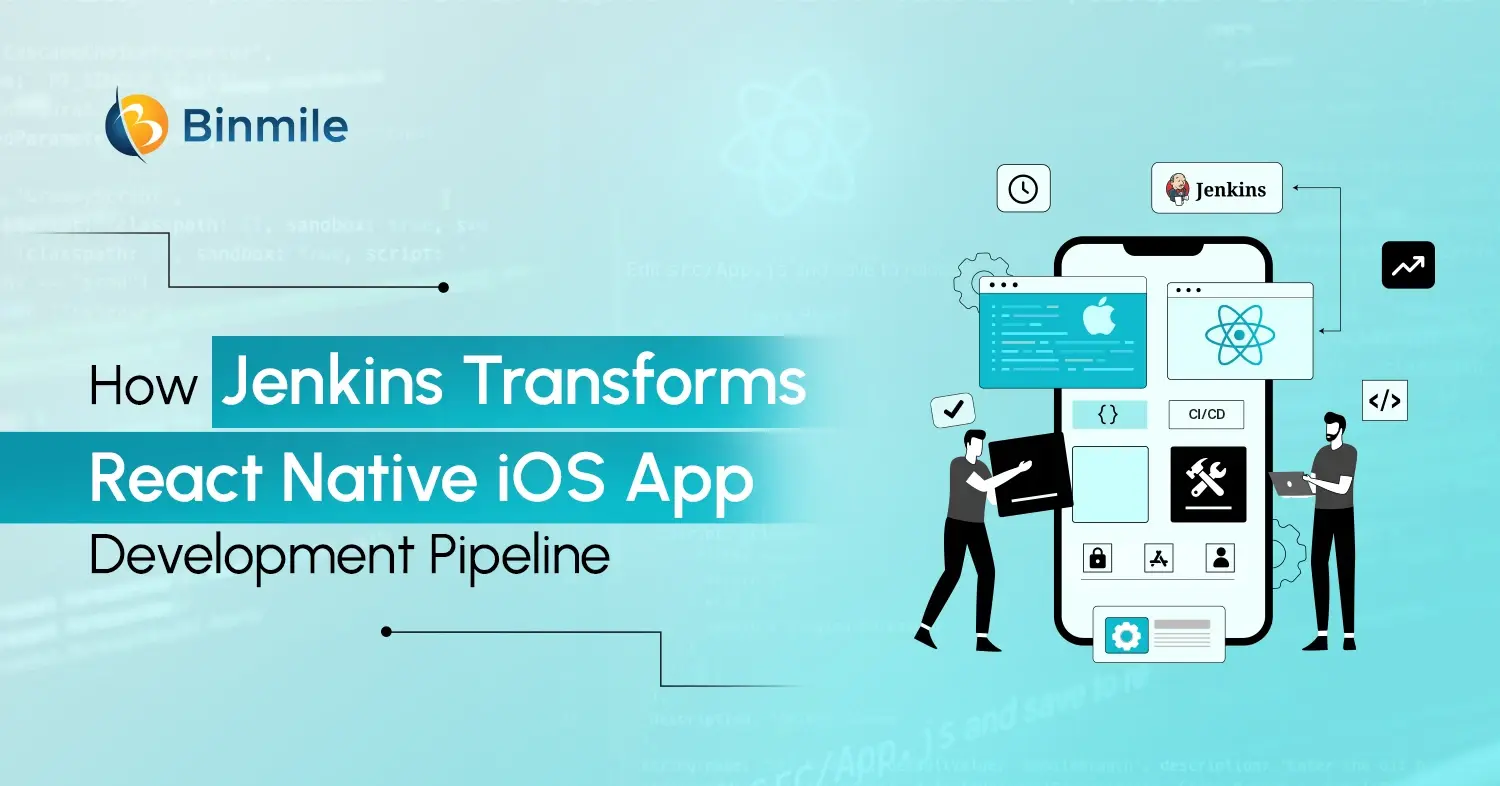To build high-functioning, secure, and versatile apps, developers need more than just frameworks and platforms. Successful application development requires the right set of tools to streamline workflows, accelerate timelines, and enhance collaboration. The best mobile app development tools not only simplify the coding process but also offer a standardized platform and source control tools. This allows developers to concentrate on building functional applications rather than focusing on technical complexity.
However, there are multiple app development tools in the market; choosing the right ones can be overwhelming. That’s why in this blog, we will guide you through the top app development tools across categories, whether it is web app development tools, Android app development tools, or exploring no-code app development tools. We will discuss our top picks, break down key benefits of app development tools, in addition, we will also explore the top tips to help you select the app development tools for your projects.
Must-Have App Development Tools: The Ultimate Picks for Every Developer
From building a complex enterprise app, a startup MVP development, or a software internal tool, the right tools can lower costs and timelines. We are listing our 15 widely-used mobile app development tools with their key features, pros, and cons to help you decide which suits your project:
1. Flutter

Flutter is Google’s open-source UI toolkit for building cross-platform applications (iOS, Android, web, and desktop) from a single codebase using the Dart programming language. It emphasizes expressive, custom UI, native-like performance, and rapid development cycles.
5 Key Features of Flutter:
- It offers Hot reload (fast iteration)
- Rich, customizable widgets & UI components
- Single codebase for multiple platforms (mobile, web, desktop)
- Native-like performance via its rendering engine (Skia)
- Large ecosystem of packages/plugins & strong community support
Pros of Flutter:
- Very fast development, changes are visible in seconds.
- High performance, good smoothness with animations.
- Uniform look across platforms, with less platform-specific UI code.
- Good support and backing from Google; regular updates.
- Strong tooling & debugging capabilities.
Cons of Flutter:
- Larger binary/app size compared to minimal native apps.
- Dart is less common; it has a complex learning curve for developers unfamiliar with it.
- Some platform-specific APIs or features may require native code bridges.
- Web/Desktop support isn’t always as mature as mobile.
2. React Native

React Native is a framework from Meta (formerly Facebook) that allows building mobile apps using JavaScript (or TypeScript), leveraging the React library. It compiles to native components for iOS and Android, enabling shared code and the reuse of web development skills.
5 Key Features of React Native:
- Reusable UI components
- Fast refresh / hot reloading
- Extensive library of third-party plugins & modules
- Access to native modules when needed
- Strong community and ecosystem
Pros of React Native:
- Faster cross-platform development & lower cost than separate native apps.
- Many developers are already familiar with JS/React; it’s an easier ramp-up.
- Good performance for many types of apps.
- Rich component ecosystem; a lot of shared work.
- Strong community support, many open-source solutions.
Cons of React Native:
- Performance can degrade for very graphics-intensive or complex animation UIs.
- The bridge between JS and native code can be a bottleneck.
- Some features lag behind platform SDK updates.
- Managing native build/configuration (Xcode, Gradle, signing, etc.) is still needed and can be complex.
3. .NET MAUI (Multi-platform App UI)

.NET MAUI is Microsoft’s cross-platform UI framework, successor to Xamarin. Forms, for building native apps across Android, iOS, Windows, and macOS using a single C# / .NET codebase with shared UI definitions.
5 Key Features of .NET MAUI:
- Single project structure targeting multiple platforms
- Native UI controls & platform-specific features
- Hot reload & productivity tools via Visual Studio
- Integration with the .NET ecosystem (libraries, tools, Azure, etc.)
- Ability to share business logic + UI code
Pros of .NET MAUI:
- For teams already in the .NET ecosystem, it is a natural choice.
- Good performance, since native controls are used.
- Productivity via shared tooling, IDE support, hot reload, etc.
- Cross-platform yet more “native UI feel” for each OS.
- Strong backing (Microsoft) and increasing maturity.
Cons of .NET MAUI:
- App size can be large because of .NET runtime & libraries.
- Some platform-specific customizations are still needed; UI parity is not always perfect.
- Learning curve for those coming from a non-.NET/Windows stack.
- Ecosystems are newer than more mature ones; some libraries/plugins may lag.
4. Kotlin Multiplatform

Kotlin Multiplatform (KMP) is a tool by JetBrains that allows sharing code (especially business logic) across platforms (Android, iOS, web, desktop) while letting you write platform-specific UI. It emphasizes reuse without fully enforcing the “one UI fits all” principle.
5 Key Features of Kotlin Multiplatform:
- Shared business logic in Kotlin, native UI per platform
- Integration with native tools (Jetpack Compose, SwiftUI, etc.)
- Support for many platforms (Android, iOS, web, desktop)
- Strong tooling from the JetBrains / Kotlin ecosystem
- Flexibility: pick how much to share vs platform-specific
Pros of Kotlin Multiplatform:
- High code reuse, especially for logic, reduces duplication and bugs.
- Near native performance since compiled to native binaries or using native runtimes.
- Good option for teams already using Kotlin.
- Allows platform-specific optimizations where needed.
- Growing community and increasing adoption.
Cons of Kotlin Multiplatform:
- UI code often must be written separately per platform (if not using shared UI tools), which requires more effort.
- Some parts are still experimental or less mature, with fewer ready-made libraries in some domains.
- Learning curve: need to understand the paradigms of multiple platforms.
- Build & debugging setup for sharing code + platform-specific code can become complex.
5. Ionic Framework

Ionic is an open-source framework for building cross-platform apps using web technologies (HTML, CSS, JavaScript/TypeScript), often combined with frameworks like Angular, React, or Vue. Apps run in webview / via tools like Capacitor, Cordova, or as PWAs.
5 Key Features of Ionic:
- Rich UI component library styled for mobile look & feel
- Support for multiple frontend frameworks (Angular, React, Vue)
- Plugins (Capacitor / Cordova) to access native device APIs
- Good PWA support (web apps behaving like mobile)
- CLI tools & tooling for building / live reload / dev workflow
Pros of Ionic:
- Web developers can pick it up more easily.
- Fast prototyping, lower startup cost.
- Wide plugin availability for standard device features.
- Can target multiple platforms, including web/PWA, which provides greater reach.
- UI components make it faster to build nice-looking apps.
Cons of Ionic:
- Performance tends to lag behind native in high-demand graphics or animations.
- Reliance on webviews can cause inconsistency in UI feel, possibly lag.
- Plugin dependencies are sometimes unstable or poorly maintained.
- Larger overhead/battery/memory usage vs native or more optimized cross-platform tools.
6. NativeScript

NativeScript is an open-source framework that lets you build truly native mobile apps (iOS & Android) using JavaScript or TypeScript (and optionally frameworks like Angular or Vue). Unlike hybrid tools, it doesn’t use WebViews for rendering UI but uses native UI components.
5 Key Features of NativeScript:
- Native UI components rather than web-view rendering
- Full access to device APIs natively via JavaScript / TypeScript
- Integration with Angular, Vue, etc
- NativeScript Sidekick & plugin marketplace for templates/plugins
- Consolidated tooling & CLI support to build, test, and debug.
Pros of NativeScript:
- Better performance and native UI feel compared to many hybrid/webview-based frameworks.
- Ability to use JavaScript/TypeScript – familiar to many web devs.
- Access to OS-level features without big bridging overhead.
- Flexible in mixing platform-specific code where needed.
- Growing plugin/marketplace support.
Cons of NativeScript:
- Some native modules/plugins may be less mature / fewer in number than those for Flutter or React Native.
- Learning curve when dealing with native APIs and debugging across platforms.
- App size/startup time can be larger than minimal native apps.
- Community is smaller relative to React Native / Flutter; fewer examples / fewer third-party integrations in some niches.
7. Apache Cordova

Apache Cordova (formerly PhoneGap) is a hybrid framework that allows developers to build mobile apps using web technologies (HTML, CSS, JavaScript), wrapping them in a native container so they can run on iOS, Android, and other platforms, and access device APIs via plugins.
5 Key Features of Apache Cordova:
- Use of WebView + HTML5/CSS/JS for UI & logic
- Plugin architecture for device APIs (camera, GPS, etc.
- Cross-platform support for many mobile OSes.
- CLI tool to build, package, and debug apps.
- Community plugins & extensions.
Pros of Apache Cordova:
- Very accessible for web developers; reuse existing web code & skills.
- Low barrier & cost of entry.
- Works well for simpler apps that don’t require heavy graphics or advanced animation.
- Large plugin ecosystems.
- Suitable for quick MVP / prototypes.
Cons of Apache Cordova:
- Performance is often worse vs native, particularly graphics/animation-heavy parts.
- UI inconsistency; webview wrapper can make apps feel less “native”.
- Plugin maintenance/compatibility can be a problem.
- Limited capabilities for cutting-edge native features or newer OS APIs, unless a plugin is available.
8. GitHub Copilot

GitHub Copilot is an AI-powered coding assistant that integrates directly into your IDE. It helps developers write code faster by suggesting entire lines, functions, or files in real time. Built on OpenAI’s Codex, it’s designed to streamline development, reduce repetitive tasks, and improve coding efficiency.
5 Key Features of GitHub Copilot
- Suggests complete lines or blocks of code as you type.
- Converts comments into functional code.
- Automatically creates unit tests based on your code.
- Offers suggestions to clean and optimize code.
- Suggests changes directly within GitHub PRs
Pros of GitHub Copilot
- Speeds up boilerplate and repetitive coding tasks.
- Improves productivity for experienced and novice developers alike.
- Supports multiple languages and frameworks.
- Enhances code quality with real-time suggestions.
- Integrates seamlessly with popular IDEs like VS Code.
Cons of GitHub Copilot
- Suggestions may be inaccurate or contextually off.
- Requires human review to avoid bugs or security flaws.
- Limited effectiveness on poorly structured codebases.
- May raise concerns around code originality and licensing.
9. Xamarin

Xamarin is Microsoft’s framework (under the .NET family) that allows development of cross-platform mobile apps (iOS, Android) using C#. You can share business logic across platforms, and with Xamarin. Forms or newer MAUI share UI in many cases.
5 Key Features of Xamarin:
- Shared codebase in C#/.NET for logic and sometimes UI
- Access to native APIs, full OS-level capabilities
- UI frameworks like Xamarin.Forms to define cross-platform UI
- Integration with Visual Studio tooling, debugging, and testing
- Support for mobile features (camera, GPS, sensors, etc.) via bindings/plugins
Pros of Xamarin:
- Reuse of code, especially for logic, reduces duplication.
- For teams proficient in C#/.NET, the steep learning curve is lower.
- Native capabilities with good performance.
- Strong enterprise support and toolchain.
- Ability to target multiple platforms/ including possibly Windows.
Cons of Xamarin:
- App size and startup overhead are sometimes larger.
- UI shared code sometimes feels less “native” or needs per-platform tweaks.
- Smaller community size compared to React Native or Flutter, with some plugin shortages.
- Learning curve if the team is unfamiliar with .NET mobile paradigms.
10. Firebase

Firebase is Google’s mobile & web application development platform offering backend-as-a-service. It provides tools like real-time database, authentication, functions, analytics, hosting, etc., often used together with UI frameworks to build full apps.
5 Key Features of Firebase:
- Real-time / Firestore database & data sync
- Authentication/user management (social login, etc.)
- Cloud functions / serverless backend logic
- Analytics, crash reporting, and monitoring
- Push notifications, storage, etc.
Pros of Firebase:
- Speeds up backend setup; many features out of the box.
- Scalable infrastructure managed by Google.
- Helpful SDKs, good integration with mobile/web frameworks.
- Good for prototyping or apps where backend complexity is moderate.
- Strong monitoring and analytics tools help production apps.
Cons of Firebase:
- Costs can rise at scale due to pricing complexity.
- Vendor lock-in risk (hard to migrate away).
- Less control over backend internals, less suited for highly specialized backends.
- Some latency limitations apply to very low-latency or real-time heavy applications.
11. OutSystems

OutSystems is a low-code/rapid-application-development platform focused on enterprise apps. It offers visual development, drag-and-drop UI, integration with existing systems, automation, and aims to reduce time to market for business-critical apps.
5 Key Features of OutSystems:
- Visual UI & workflow builder
- Full stack (front end + backend + integrations) capabilities
- Reusable components & templates
- Scalability & enterprise-grade security, monitoring
- Support for deployment, versioning, and lifecycle management
Pros of OutSystems:
- Very fast delivery of business apps, especially internal tools.
- Less coding needed; good for teams with mixed development skills.
- Built-in support for security, scalability, and integrations.
- Suitable for prototyping & also for more robust enterprise apps.
- Often reduces maintenance overhead with reuse & standardization.
Cons of OutSystems:
- Licensing and costs are high, making it potentially cost-ineffective for small apps.
- Custom or unique UI/UX or behavior may be more complicated to accommodate.
- Vendor lock-in: moving off the platform can be difficult.
- Performance limitations in the case of extremely customized or complex UI/rendering.
12. Appy Pie

Appy Pie is a no-/low-code app builder aimed at non-technical users and small businesses. It uses drag-and-drop tools, templates, and pre-built modules to assemble mobile apps without writing code.
5 Key Features of Appy Pie:
- Drag-and-drop UI builder
- Templates and pre-built modules (forms, maps, galleries, etc.)
- Publishing support (app stores, etc.)
- Integrations (APIs, services) & basic backend tools
- Usually subscription-based plans
Pros of Appy Pie:
- Very easy for non-developers or business people to build apps.
- Rapid prototyping / MVPs are possible with minimal cost/time.
- No need to manage infrastructure or deep code.
- Templates enable a decent look & feel quickly.
- Low maintenance overhead for simple apps.
Cons of Appy Pie:
- Limited flexibility/custom features; hard to extend.
- Performance or polish may lag behind coded apps.
- Complex custom logic may not be supported.
- Depending on the platform, recurring costs may be incurred.
13. Mendix

Mendix is a low-code platform for building enterprise and business apps, with strong support for collaboration, integrations, process automation, and lifecycle management. It allows both citizen developers and professionals to contribute.
5 Key Features of Mendix:
- Visual modelling & drag-and-drop UI / workflows
- Integration with external systems (APIs, databases)
- Versioning, deployment pipelines, and monitoring
- Reusable components & modules
- Security & compliance features built in
Pros of Mendix:
- Highly productive for enterprise business apps.
- Easier to maintain and iterate.
- Good for organizations with governance and regulatory requirements.
- Less coding needed; can engage non-dev resources.
- Strong support/vendor assistance.
Cons of Mendix:
- Cost/licensing tends to be high.
- Less suitable for highly customized or graphics-intensive / game apps.
- UI/UX may be less fine-tunable compared to full code frameworks.
- Potential vendor lock-in/platform constraints.
14. Framework7

Framework7 is an open-source framework for building hybrid & web-based mobile apps using HTML, CSS, JS, often with Vue or React. It provides UI components styled for the mobile OS look and feel. Usually paired with Cordova/Capacitor for native device access.
5 Key Features of Framework7:
- Mobile-style UI components (iOS, Android) out of the box
- Support for frameworks such as Vue and React.
- Simple router, transitions, etc., for a mobile app feel
- Integrations with device APIs via plugins/wrappers
- CLI & tools for building, packaging
Pros of Framework7:
- Very good when UI is important and you want a mobile-native look using web tech.
- Developers with web skills can build quickly.
- Lightweight for simpler apps.
- Flexible with choice of front-end frameworks.
- Good for PWAs as well.
Cons of Framework7:
- Performance is not as high for heavy animations/graphics vs native.
- Device API access may depend on community plugins; fragmentation.
- UI may feel less “native” in edge cases or less smooth on some devices.
- Less popular; smaller community compared to Ionic, React Native etc.
15. SwiftUI + Xcode

SwiftUI is Apple’s declarative UI framework for building native iOS (and other Apple platforms) apps, used via Xcode. It allows building UI declaratively, with previews, adaptive layouts, and modern Apple-platform features.
5 Key Features of SwiftUI + Xcode:
- Declarative UI definitions
- Live previews & interactive design in Xcode
- Tight integration with iOS/macOS APIs & features (gestures, animations, etc.)
- Adaptive layout, dark mode, accessibility built in
- Performance optimized for Apple devices
Pros of SwiftUI + Xcode:
- Best performance & UI fidelity on Apple devices.
- Access to the latest iOS features as soon as Apple releases them.
- Very polished UI/UX; good developer tools.
- Good for complex animations, AR, etc., on the Apple platform.
- Strong support, documentation, and long-term stability.
Cons of SwiftUI + Xcode:
- Only works for Apple platforms; for Android, a separate tool is required.
- Learning curve for SwiftUI’s declarative paradigm if coming from imperative UI.
- SwiftUI is still evolving; some gaps/bugs or missing features for advanced custom needs.
- Need macOS hardware to use Xcode; deploying to multiple platforms requires multiple toolchains.
How to Choose the Right App Development Tools for Your Project
After discussing different app development tools, it is also essential to understand how to select the right mobile app development tools for your projects. Here are 5 tips for you:

1: Define Platform and App Type
Select whether you want to build iOS or Android or both, and whether the app will be a native based, hybrid-based, or web-based. This will help you decide the tools that are compatible and efficient for your app development process and its goals.
2: Match Tool Features to Requirements
Decide your app’s core features, such as offline access, push notifications, or real-time updates, and choose the tools that will provide them natively. You must avoid tools that require too many third-party integrations to meet basic functionality.
3: Check Integration and Compatibility
Ensure that the app development tools integrate well with your existing technology stack, including databases, APIs, and CI/CD pipelines. Incompatible systems can lead to delays, bugs, and increased maintenance costs.
4: Evaluate Community and Documentation
Choose tools that have an active developer community and documentation, as it will help you in effortless troubleshooting issues and finding tutorials. This not only enables you to get the desired support you want but also keeps up with the best practices and new releases.
5: Test Performance and Scalability
Run a small prototype to evaluate performance under load and ease of scaling. Consider other features, such as how well the tool handles memory usage, response time, and concurrent connections. Tools that do not perform well during the first testing will unlikely support the long-term growth or a high number of users.
Final Remarks on App Development Tools
Without a doubt, the decision to choose the best app development tools can make or break your project. After all, these best mobile application development tools help you manage complex app development processes, lower the development cycle, and enhance the efficiency of the entire process. However, you must ensure that whatever tool you select, you evaluate your project requirements before you choose any of the tools. Remember, your team is as good as the software tools that they use, and vice versa!
However, the app development market offers a wide variety of tools, many of which we have discussed here. Hopefully, this blog has given you an in-depth analysis of the top 15 tools, including their features, pros, and cons. We also discussed the criteria you should consider before selecting any tool for your development team. With the right tools in place, your app development team can focus on building innovative, high-performing apps that stand out in today’s competitive market. Staying informed and choosing wisely ensures your project is built on a solid foundation from day one!









